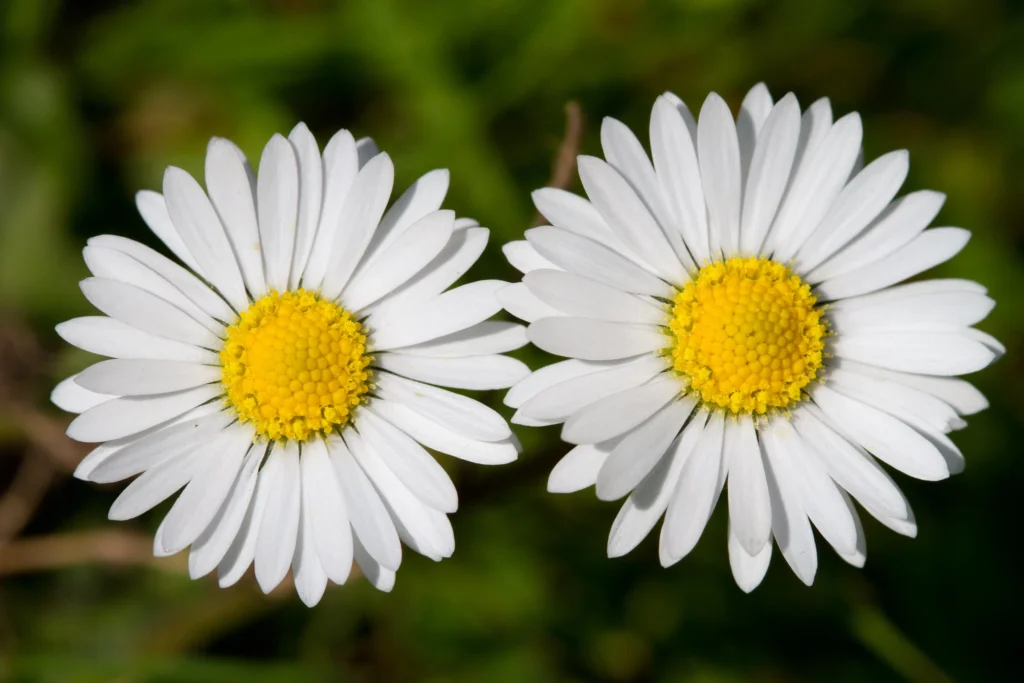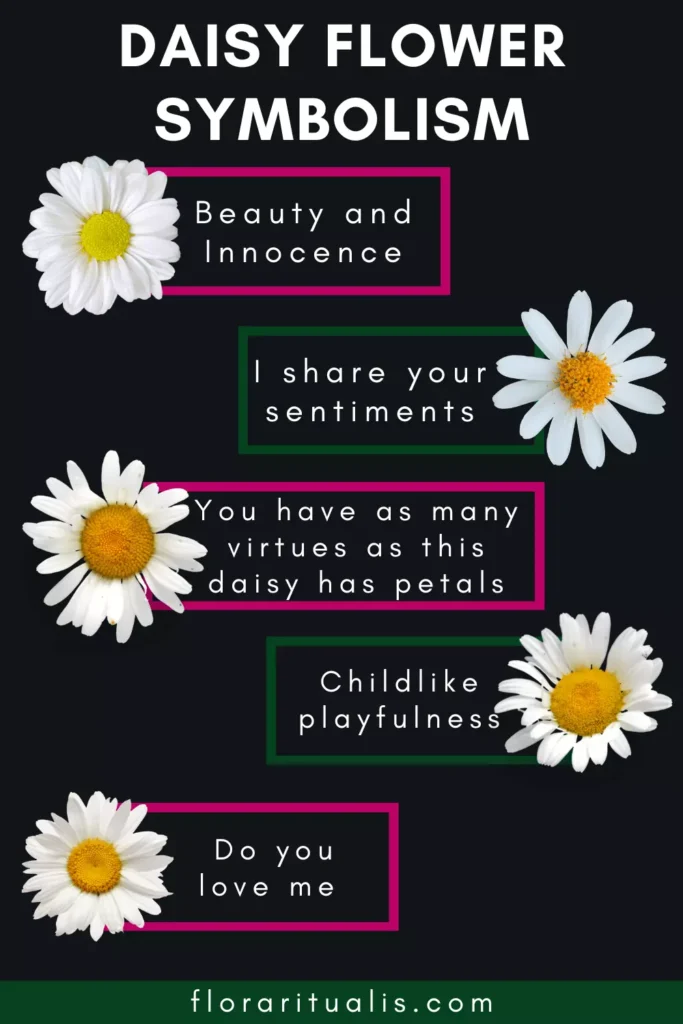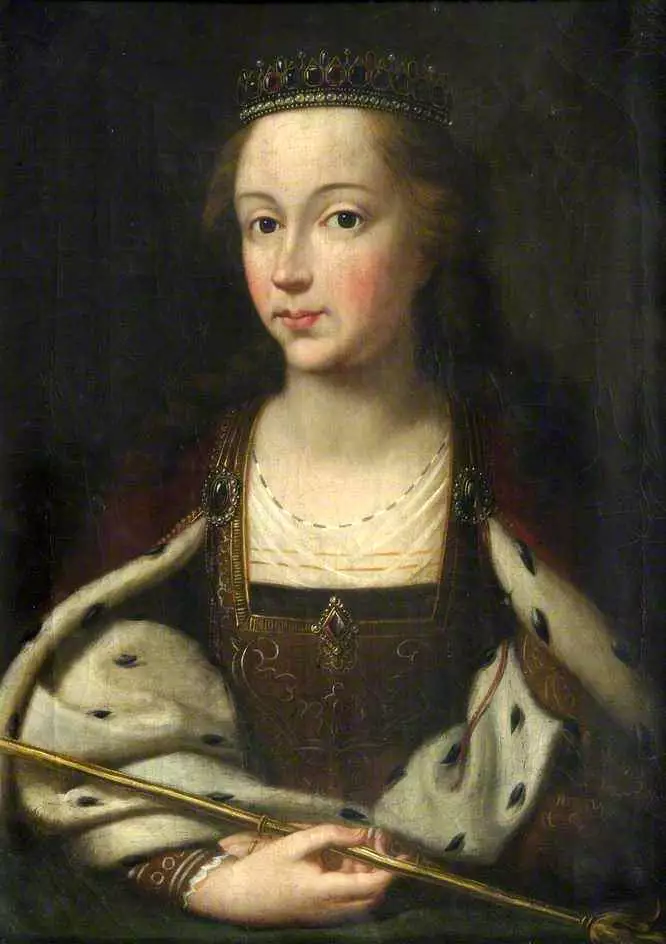The meaning of the daisy flower is found in a lot of various cultures. The name daisy derives from old Anglo-Saxon words “daeges” and “eage”, this translates to “day’s eye” or “eye of the day.”
The flower falls under the dominion of the planet Venus and the zodiac sign of the Cancer. It will make a perfect gift for Cancerians but also to the signs of Taurus and Libra.
In this blog we will take a look at the daisy meaning using various myths and historical times. We will then explore the various types of daisies.
What does a daisy flower represent?
The daisy flower symbolises beauty and innocence, childlike playfulness and loyal love. It is also synonymous with spring through its association with the Germanic goddess Ostara. And finally it represents the qualities of the moon and Venus as alchemists place this flower under the dominion of both planets.
The meaning of the daisy furthermore, can also be acquired from its beliefs and uses during the Victorian times. It was also called the flower of the poets. This humble flower is sure to impress with its meaning, lets get right into it.
Daisy meaning in mythology
The meaning of the daisy flower can take form of metaphors in different mythologies.
The daisy is associated to the Eostre or Ostara the goddess of spring in Germanic mythology. Her name derives from the month of April which translates to “Eostremonath.”
Birth flower of Cancer, Taurus and Libra
As per alchemy and astrology the daisy flower is both under the dominion of the planet Venus and the sign of Cancer.
In Anglo-Saxon myth Ostara is the goddess of moon, fertility and spring, she was the personification of rebirth after months of European barren winter.
The goddess Ostara having links to the moon therefore reinforces the flower’s connection to the sign of Cancer which its ruler is the moon.
Furthermore, the qualities of the goddess Ostara is very close to that of the Sumerian/Babylonian goddess Ishtar/Astre. And this close connection associates her also with the planet Venus. Both signs Taurus and Libra are under the dominion of the planet Venus and hence it is a birth flower for those zodiac signs too.
Daisy Meaning in Roman Mythology
The Roman myth associated with Daisy is about the nymph Belides. She was one of the Dryads (Tree Nymphs) that presided over the forest, meadows and pastures.
One day while she was dancing with other nymphs, she attracted the attention of Vertumnus. He was the deity who presided over the orchards.
In order to escape from his gaze, she transformed herself into the flower Bellis, which is the daisy.
Daisy meaning in history
During Victorian times, women who were young and heartbroken started a custom using the flower of the daisy.
If they wished to acquire love again they would pluck the petals of the daisy one by one while signing “he loves me, he loves me not,” the last petal would then determine the future of her relationship.
Victorian children would make daisy chains as an amusement, or to form the garland of a May Day crown; a country maid might thread some through her hair as simple decoration or as an indication of her kind and innocent nature.
In France, the daisy is known as Marguerite named after Margaret of Anjou. She was the unhappy wife of Henry VI. When she was young Margaret chose the daisy as her own flower and the nobles of her court wore it her honor.
Another Marguerite is the sister of French King, Francis I. She too was fond of the flower daisy and worn in her honor.
Towards the end of the fifteenth century, the daisy came to be used in paintings of the Adoration. The sweet simplicity of the daisy would be symbolical of the innocence of the Christ.
Daisy the flower of the Poets
The daisy is known as the most common of common flowers and yet it didn’t stop Britain’s best poet to be charmed by its simplicity. The meaning of the daisy flower takes various interpretations in different poems.
It was Chaucer’s favourite flower and in his Legends of Good Women, he uses the daisy as a metaphor for transformation.
Alceste in the poem has several relations to the daisy. At first she dresses in a way that imitates the daisy. Then she becomes metaphorically equivalent to the daisy.
Shakespeare also uses the symbolism of the daisy to represent innocence. In one scene of Hamlet, we find Ophelia hands Queen Gertrude a daisy.
This seems to signify that her fickle love cannot expect consistency from her deceitful husband. However, when Ophelia drapes herself into garlands of flowers before drowning it symbolizes her innocence.
Different types of Daisies
Oxeye Daisy
The Oxeye Daisy or Marguerite in French. This flower is native to Europe and to some parts of Asia.
The plant can grow up to 24inches or 60cm. The stem of plant is usually hairy on the lower parts than the upper parts.
Each plant gives up to three daisy flowers. The Oxeye daisy has around 15 to 40 petals that surround a yellow disc.
They flower around late spring to early summer.
English or True Daisy
English Daisy or Lawn Daisy due to its ability to establish itself on lawns invasively.
This flower is native to Europe however, it has become a common wild plant in North America.
The plant grows 0.8 to 2inches or 2 to 5 cm tall. It grows very close to the ground on leafless stems.
The flowers are 0.8 to 1.2 inches or 2 to 3 cm in diameter with a yellow disc.
They flower from from early to midsummer. However, under the proper circumstances they might produce a few flowers in mild winters.

Shasta Daisy
Shasta Daisies are similar to the Oxeye Daisy in appearance but are larger in size.
The plant grows stiff stems that can grow up to 4 feet or 120cm. They bear flowers that are white or creamy with heads that are yellow in color.
While the flowers are similar in appearance to that of the Oxeye Daisy, they are bigger in size and may reach a diameter of 4 inches or 10cm.
They flower around mid summer to late summer.

Daisy Uses
- In ancient Rome, it served as a herbal medicine due to its astringent properties.
- The Roman surgeons who accompanied the Roman legions into battle would order their slaves to pick sacks full of daisies in order to extract their juice.
- In order to bind swords and spear cuts, the daisies were soaked in this juice. The daisy is still has uses in homeopathy for wounds and after certain surgical procedures, as well as for blunt trauma in animals.
- Daisies also had the utility to treat coughs, asthma and nervous excitability. Additionally, it serve as eye lotion to treat conjunctivitis.
- The Roman surgeons who accompanied the Roman legions into battle would order their slaves to pick sacks full of daisies in order to extract their juice. The leaves of the daisy were used as wound dressing.
If you enjoyed our blog on the daisy flower meaning then make sure to check out our other blog under the dominion the moon and also those under the dominion of venus.

FAQs Daisy Flower
References
Dietz, S. T. (2022) The complete language of flowers the complete language of flowers: A definitive and illustrated history – pocket edition. Wellfleet Press.
Folkard, R. (1884) Plant lore, legends, and lyrics. Embracing the myths, traditions, superstitions, and folk-lore of the plant kingdom. London: S. Low, Marston, Searle, and Rivington.
Junius, M. M. (1993) The practical handbook of plant alchemy: Herbalist’S guide to preparing medicinal essences, tinctures and elixirs. Rochester, NY: Inner Traditions Bear and Company.
Kirkby, M. (2011) A Victorian flower dictionary: The language of flowers companion. New York, NY: Random House.
Deena Bsingh, a UK-born, Mauritius-raised content writer, is a dedicated explorer of the ancient world’s hidden treasures. Armed with classical studies knowledge and a decade of spiritual immersion, Deena delves deep into the wellspring of ancient wisdom. Her illuminating writings on flower meanings and culinary history are imbued with the profound insights she has gathered on her journey. Through her Medium articles, she guides readers on transformative journeys that bridge the gap between ancient cultures and contemporary consciousness, offering a rich tapestry of understanding that endures through time.



